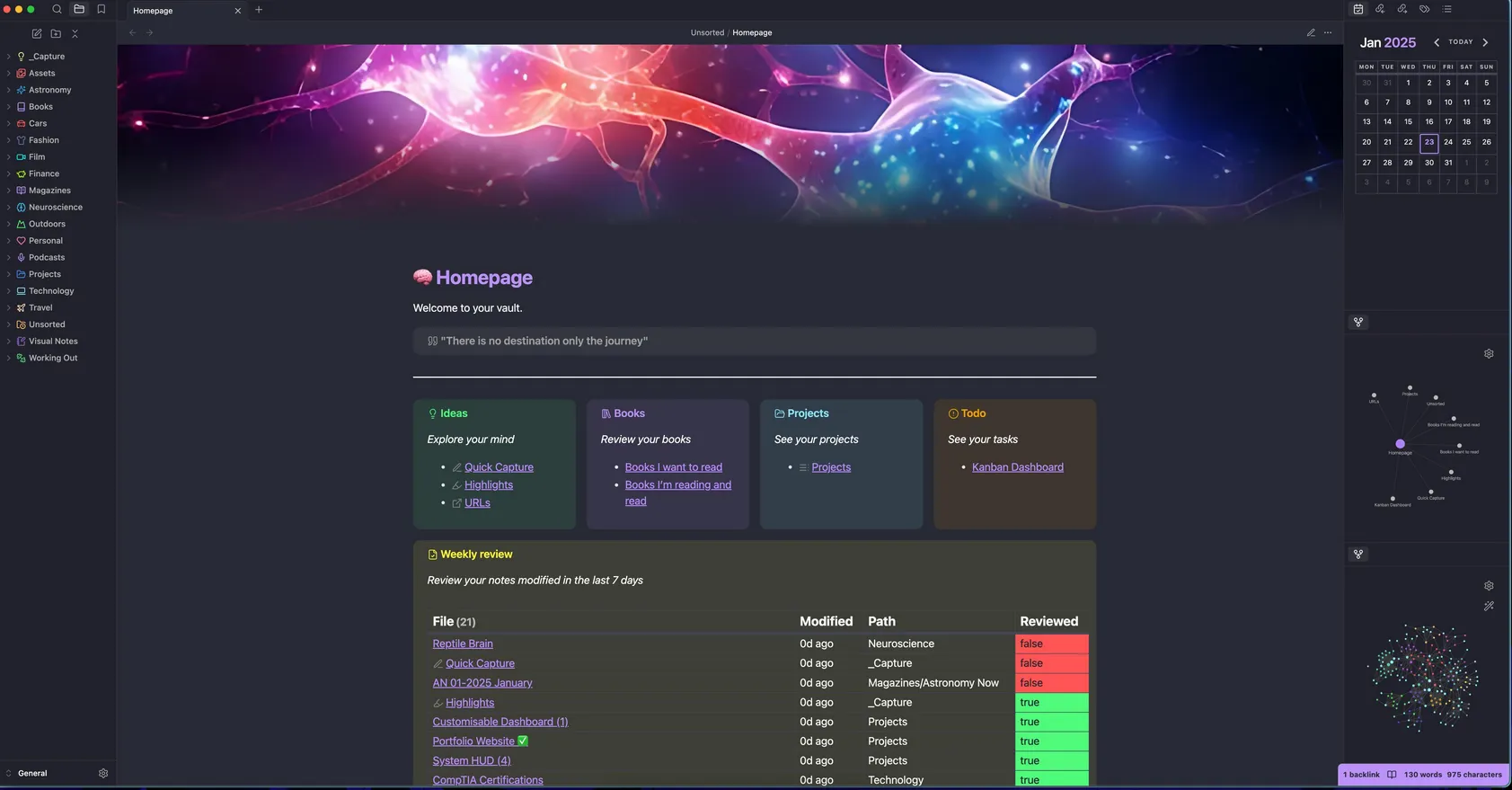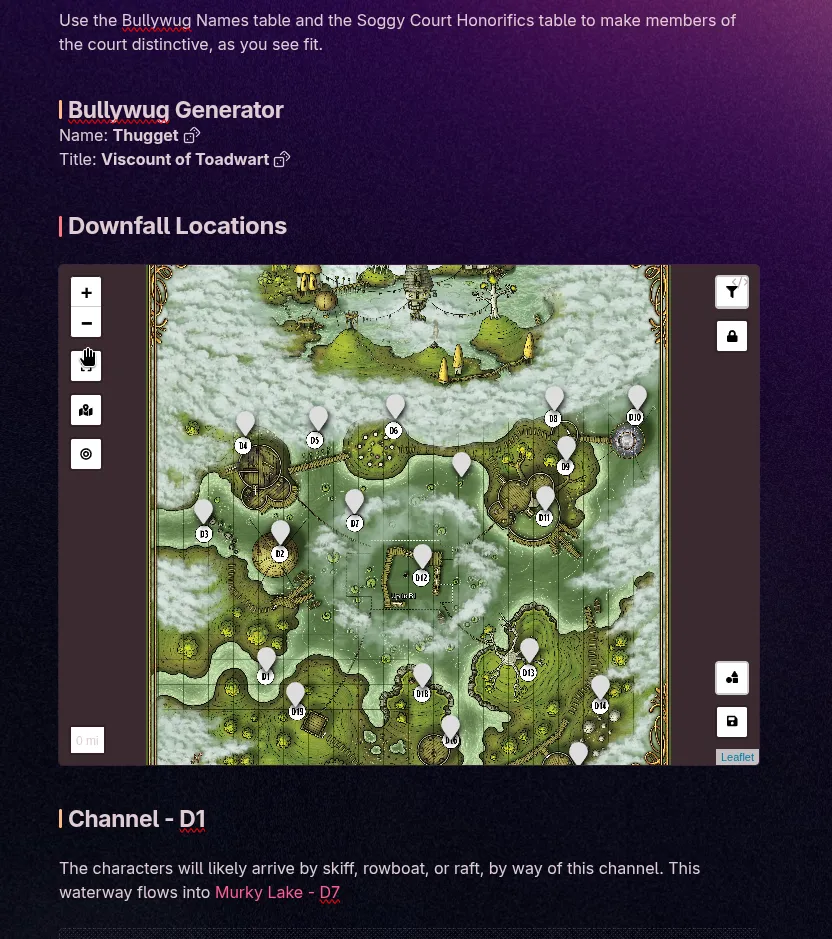This is a long, personal diatribe on Obsidian, my most used application. Written for Obsidian October 2025!
I started forcing myself to write tasks and troubleshooting/implementation steps down while in the middle of doing them back in August of 2023
There wasn’t one specific thing that prompted me to start the habit, but a combination:
- At the time I was about a year and a half into the most technically challenging job I’ve ever had.
- I was making the rocky transition from Windows/Office365 System Administrator to Solo Linux Sysadmin/DevOps guy (small org, wearing a lot of hats, the usual)
- The previous person in my role was extremely passionate about maintaining a usable wiki of Infrastructure, break-fixes and operational knowledge, and I wanted to keep that dream alive.
- I was taking over as Dungeon Master for my fortnightly D&D game and was taking a lot of preparation notes
- Most scarily, I was noticing my snappy mid-20s brain was starting to slow down and forget things more and more - Most likely due to the chaotic nature of a small organisation and changing priorities
In my previous life as a windows admin, I had tried an unstructured form of Personal Knowledge Management (PMK) using Onenote. However, because I used the Office365 version all those notes belonged to my work, and I was promptly locked out of all that knowledge when I inevitably finished my time there.
So I had my criteria - I needed a note-taking application that I either self-hosted or ran locally, I needed it to be cross platform at least between Windows and Linux (I was flirting with the idea of ditching windows entirely by this point) and that was really it.
Enter Obsidian - Local first, cross platform (windows, linux and android!), markdown editor so it’s formatting was supported across basically the entire internet, and with a healthy plugin ecosystem to solve any problems the base software didn’t!
I know, another Linux guy using obsidian, really breaking the mould here. But there’s a reason.
Making the habit
My advice for those just starting out is to ignore the noise and online communities around Obsidian. Download it, create a new vault, and just go. I fell for a few tips and tricks I saw on reddit, but otherwise when I started I had an extremely simple workflow
Every day I would start a new page with today’s date. Every time I did something that day, I would write a new heading in my own words for what I was doing (e.g. Deploying new server to AWS Prod), I would add a few tags, and then I would start writing on my second screen as I went, for example:
I'm trying to deploy a server from $REPO, using a cloudformation template $template
`ansible-playbook deploy.yml`
First attempt, I received the following error...Starting in this relatively simple way had a number of advantages. Firstly, I was writing in my own words, which meant if I ever needed to search something up after the fact, I could generally find it quite easily.
I was also using a very rudimentary tagging system so it was possible for me to search for and review anything related to AWS.
By far the most important thing I was doing was building a habit of documenting things as I went. Writing down my thought process, exactly why I fixed things the way that I did, and how I even diagnosed them in the first place. Building a habit like this is difficult, I’m not going to lie about that, but it was made infinitely easier when the workflow itself was SIMPLE.
If I had started by trying to force myself to use zettelkasten while also backlinking all of my notes, and writing full wiki pages for each technology concept I briefly mention, I would still be keeping contextless snippets of code in untitled(1).FINAL.JOSH-DONT-FORGET.txt on my desktop, or perhaps worse, just forgetting stuff entirely.
Time-capsuling my brain
It is because of this habit that I can tell you that on August 15th of 2023, I was diagnosing a 504 error from an internal middleware service. I can tell you what logs I checked, I can tell you what error I saw in those logs, and I can tell you what I did to resolve the error. I can also tell you that same error occurred in December 2023 and I solved it in maybe 25% of the time.
In my line of work (with my workload and lack of predictability and a need for focus time to get quality work done), this is essentially a superpower. Being able to reference my own notes built up over two years to check if I’ve ever encountered a similar problem, or needed a similar grep command to search in a particular way saves me more time than googling the same question once a week, stumbling through the same pages or forum posts to get what i’m after.
This kind of note-taking is also very helpful for my colleagues. If I ever diagnose and implement a break fix, I can spend a bit of time cleaning up my personal notes and copy-paste the result straight into our internal wiki for future reference - Here’s what happened, here’s how I found it, here’s what I did about it.
Unfortunately for me, once I got a taste for note taking and all the good it did for me, I wanted to know more, I wanted to know how the Obisidan Pros did things.
The internet is for (productivity) porn
If you spend nearly any amount of time on the internet looking for tips and tricks for managing your own personal documentation, you’ll very quickly find a rather large subset of posts and content that I personally categorise as “Productivity Porn”
These are your self-help guru equivalents in the PMK community - “Why you MUST use Zettelkasten in Obsidian!”, “Download my Vault Demo”, “Check out this incredibly convoluted tagging system that matches my extremely specific workflow!”
Instead of sticking to the tried and true KISS Principle, I fell for these hook, line and sinker. At first it started small, I “improved” my workflow by automating creation of new daily notes, with their titles already filled out and ready for me.
Then I started dividing my notes out instead of keeping them all in the one daily note - Meeting minutes would go in their own folder, Fleeting Notes (something I adopted from zettelkasten without really understanding the concept) would go elsewhere, and I’d still use my daily note but more as a scratch pad with an attached to-do list.
Then things got out of hand, I saw someone on reddit created a whole Dashboard in Obsidian… Woah! I thought, How can I recreate that?

I was spending so much time tweaking, customising, thinking about my note-taking workflow and how to automate different parts that I had basically stopped taking all but the most basic of notes during my day. I’d added too much friction, and that was reflecting in the quality and quantity of notes I would take.
Not all who customise are lost
The above isn’t to say that i’m against customisation! Quite the opposite, i’m a too frequent visitor of assorted “ricing” Linux communities, and I firmly believe that having an application or tool that looks good makes it feel good to use (and thus, easier to build habits).
I also use a very heavily customised version of Obsidian for Dungeons and Dragons prep, loaded with plugins to make my life as a DM easier - Including random table rollers & a clickable map allowing me to read about each section as my players get there (Seriously, Dice Roller and Leaflet basically turned Obsidian into a virtual DM screen, especially on an ultrawide screen, it’s a dream)

The trick with customising Obsidian is that you make a lot of changes to how it works. You can change the font, colours and theme in Obsidian which won’t affect how you take notes. On the other hand, with plugins you can automate creation of certain kinds of notes, create templates, automate tagging, even write custom CSS to change how everything displays. All of this could be extremely powerful to make Obsidian behave exactly the way you want it.
But aye, there’s the rub - It has to be the way YOU want it. I tried to take other people’s workflows and automations and incorporate them into my own vault, which resulted in creating some weird chimera of productivity, at one point I had turned on VIM shortcuts to try and force myself to use the keyboard more while also having a dashboard full of clickable buttons to create new notes from templates - That alone should probably be grounds for institutionalisation.
After a while of struggling to force myself to use this mess of a vault I ended up moving jobs, which gave me a good excuse to start a new vault and start again. That’s where i’m at today, I have 3 plugins (A calendar, an improved search plugin, and a plugin that converts natural language to dates) and no templates, I just create a daily note and write, occasionally creating links to less day-specific stuff like a shopping list or TV shows I’ve been recommended.
The second best time to start is right now
Reading the above, I’ve basically spent 2 years to end up right where I started with note taking, but that should be encouraging! I am 2 months into a new Obsidian vault and loving it. I’ve still got my old files to reference, and occasionally I’ll pull a section from an older note into a new one to begin rebuilding my knowledge base when I need it, but it’s not like I’ve missed the train and I’m starting too late to even bother.
So my lessons learned after 2 years of messing around?
- Start simple and start writing, build the habit
- Add a pretty theme, it’ll make looking at the same application every day much nicer
- Don’t install plugins unless you really need them to improve how you personally work. Plugins aren’t the enemy, hell is other people.
- Under no circumstances try to adopt someone else’s workflow. Build your own up over time, only you know how your brain works and what works best for you
- If you need to, separate your vaults. I don’t keep my personal notes and my D&D notes in the same vault, so I can set them up with different plugins and customisation
I also recommend paying for Obsidian Sync if you’re non-techy! The developers deserve it, 1 vault is about $73 AUD per year, and having notes on my phone makes it easy to just jot down ideas on the go or view my recipe notes while i’m cooking.